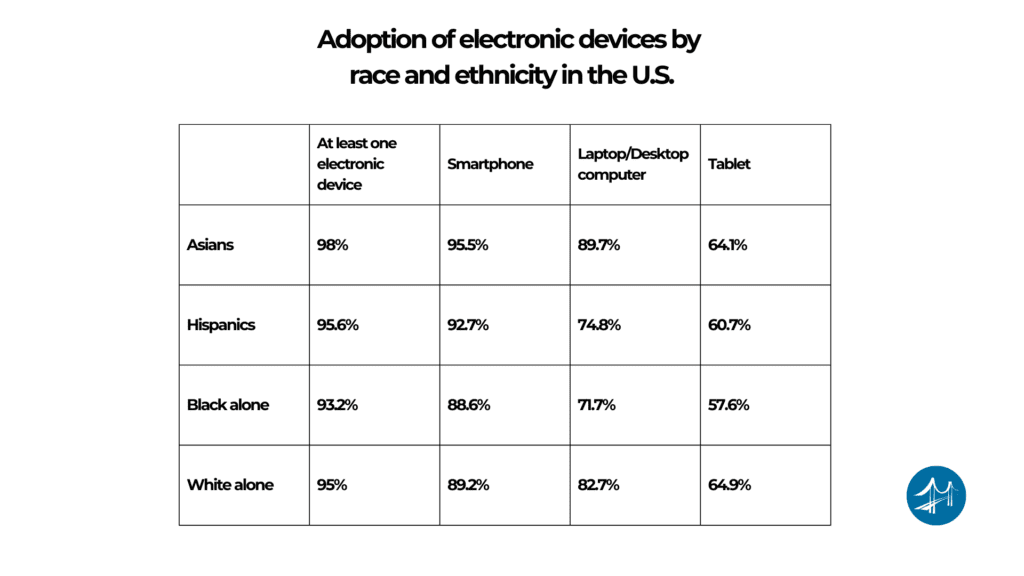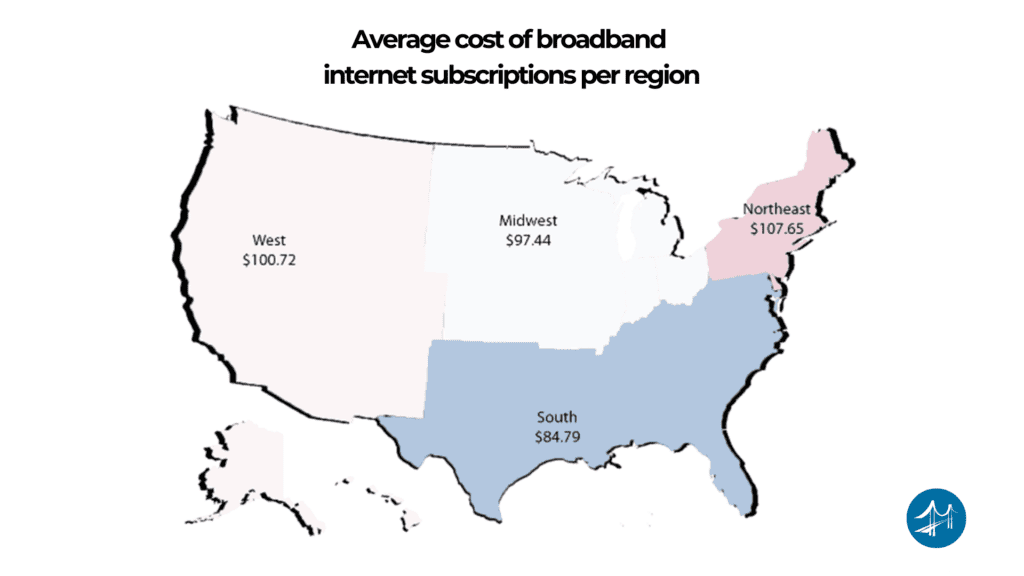Today, internet access is crucial for both personal and professional activities. The internet, once a niche service in the late 80s and early 90s, has become indispensable, especially for online shopping, virtual meetings, home automation, and everything else!
The COVID-19 pandemic underscored the importance of reliable internet access, as remote work, telehealth, and online education became essential. Most Americans -approximately 90%- own at least a smartphone. While ownership of tablets, laptops, and desktop computers varies, the means to connect are more prevalent than ever.
The American Community Survey (ACS) report highlights that over 90% of American households have internet access. Conducted by the U.S. Census Bureau, this report breaks down the adoption of computer devices and internet usage across different racial and ethnic groups, including Latinos.
Key Findings on Computer and Internet Usage
Hispanics are the second-largest ethnic group in terms of electronic device adoption in the U.S., with 95.6% owning at least one device, trailing only Asians at 98%. Smartphone adoption among Hispanics is high at 92.7%, compared to 89.2% for whites; yet desktop and laptop ownership are relatively lower at about 60%.
Although, recent years have seen widespread adoption of computers and the internet in the United States, significant disparities still exist based on socioeconomic status, age, and educational attainment.
Higher-income and better-educated households are more likely to have internet access and own computers. Additionally, younger individuals are more likely to use the internet and own digital devices. White adults are more likely to own computers and have broadband connections compared to Black and Hispanic adults.
Latino households face specific challenges in accessing computers and the internet. In 2021, only 67% of Hispanic adults reported owning a desktop or laptop computer, and 65% had a broadband connection at home, both below national averages. Many Latino households rely heavily on smartphones for internet access, with about 25% being “smartphone-only” users.
While Hispanics are the second-largest group in electronic device adoption, most of these devices are smartphones. Here’s a comparison of device ownership among different groups:
Socioeconomic and Geographic Disparities: Impact on Hispanic Households
Barriers to digital engagement for Latino households include socioeconomic factors, language barriers, and geographic location. Lower income levels and limited English proficiency can negatively affect access to digital resources, exacerbating the digital divide.
Device ownership and internet subscription rates are closely linked to household income and educational attainment. For instance, over 99% of households earning $150,000 or more have some form of computing device, compared to 85% of households earning less than $25,000. Urban households typically have higher rates of device ownership and broadband subscriptions compared to rural households.
In terms of affordability, broadband subscriptions are generally cheaper in the South and more expensive in the Northeast. According the Racial/ethnic and income disparities in neighborhood-level broadband access in 905 US cities, 2017–2021 report by Y. Li, B.R. Spoer, T.M. Lampe, P.Y. Hsieh, I.S. Nelson, A. Vierse, L.E. Thorpe, and M.N. Gourevitcha, “broadband access in majority Black and Hispanic neighborhoods was 10–15% lower than in majority White or Asian neighborhoods.” Although the lack of broadband access in urban households decreased from 30% in 2017 to 24% in 2021, racial and income disparities persist. Households with low income or those in low-income areas remain the most affected.
The National Center for Education Statistics reports that the primary reasons for children aged 3 to 18 not having home internet access were its cost or the family’s lack of need or interest (38%). Other reasons included the lack of a suitable computer (8%), unavailability of internet service in the area (5%), ability to use the internet elsewhere (3%), and privacy and security concerns (2%).
Approximately 11% of households rely solely on cellular data plans for internet access. “Smartphone-only” households are more likely to earn $25,000 or less annually, be headed by individuals aged 65 and older, or have Black or Hispanic householders. Among 35- to 44-year-old householders, 13% of Hispanic households are smartphone-only.
Digital Content and Engagement Recommendations
Effective digital engagement requires culturally relevant and bilingual content. Successful outreach programs often involve partnerships with Latino community leaders and organizations to ensure that the content reflects the cultural nuances of the target audience, as well as having these trusted partners promote said content- in essence, cutting through the noise.
For instance, digital content should be engaging and culturally relevant. Given the high reliance on smartphones, strategies should include short video guides, infographics, and specialized ads. Second and third-generation Hispanics often view Spanish-language media nostalgically, creating an opportunity for culturally resonant content. And while this is probably not new information, these tactics must remain a priority to create a successful outreach campaign for Hispanics.
To improve outreach campaigns targeting Hispanics, consider partnering with organizations experienced in digital engagement (like COOL!). Cultivating these relationships can ensure your efforts are both effective and culturally appropriate.
Graphics source: US Census Bureau ACS Reports Computer and Internet Use in the US (2018)
Image: ©SDI Productions from Getty Images Signature




